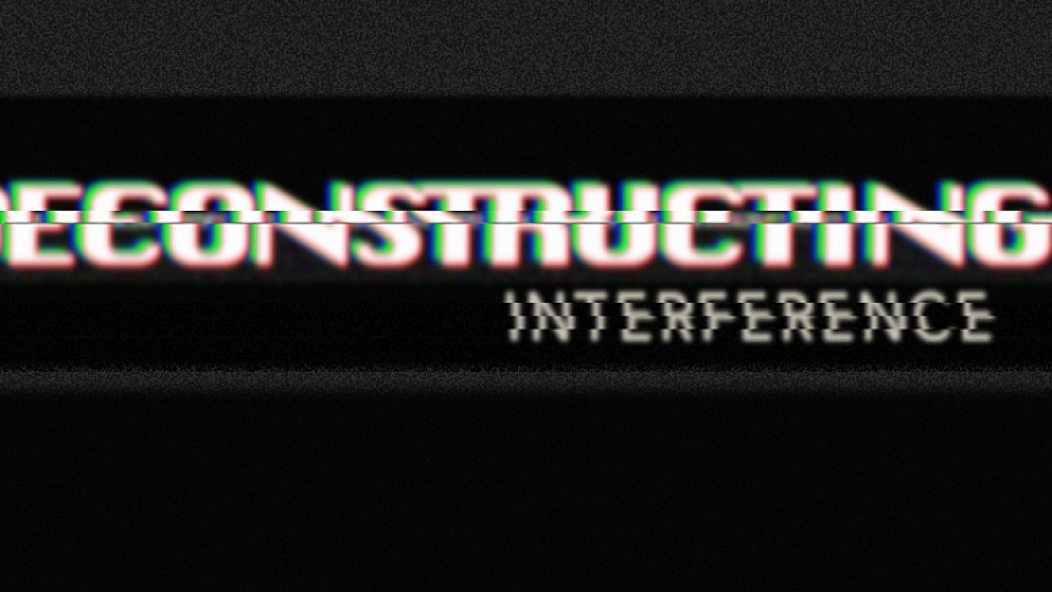
Deconstructing Interference #17

…
Since the late 1990s, Tor Lundvall has been a pioneering figure in binding the extremely dark and introspective world of dark ambient music with the lighter side of synth pop and electronica. This process resulted in the release of the brilliant A Dark Place in 2018, a seminal record in which the dark and light sides of the artist join in spectacular fashion.
In the end of April Dais Records released a very interesting collection of Tor Lundvall’s early works in A Strangeness In Motion, which included music that the famed artist has been working on as early as 1989. To put that in perspective, the debut full-length of Lundvall Passing Through Alone was eventually released almost decade later in 1997. Lundvall himself stated that he had some reservations with regard to the quality of these works, considering them “naive and youthful relics,” but he eventually grew fond of these early memories and decided to release them to the world. Even though there is some definite distance between the compositions of A Strangeness In Motion and A Dark Place, this recent collection pinpoints the origin of the artist, how he first conceived his resilient musical vision and how he formed his own identity.
There are three main lessons that Lundvall’s recent compilation brings to mind when compared to a few other recent releases. Firstly, it acts as a bizarre time machine, one that turns back the clock and reinstates a previous version of reality. Another release this month that performed the same trick was the unearthing of Bogdan Raczynski’s unreleased works, pointing to a time when the adventurous IDM scene was on the rise, and it also rehashes the importance of Raczynski’s work on the genre’s current form.
The second lesson from A Strangeness In Motion is that experimental music can rely also on simplicity. Lundvall’s early works do not feature the same depth that his later records possess, but they still display a fiercely adventurous quality. Maharadja Sweets is a completely different artist, relying on heavy electronics and folk music to produce his extravagant sound, but with his new record he took a step back and stripped the music down to its very basics. It was a process of distillation, and one that allowed the structures of Maharadja Sweets’ music to shine devoid of any sonic enhancements.
The final lesson from Lundvall’s work comes in the artist’s acceptance of his earlier work and finally releasing these to the public. Kelly Moran produced one of the finest records in 2018 and she decided to revisit many of these tracks with her new EP. While the circumstances are different, the alternate versions of Moran’s songs from Ultraviolet do provide an astounding insight into the origin of her third full-length. These are just three of the releases featured in this month’s installment, with another four excellent works presented as well. Hopefully you will enjoy listening to these.
…
Alberich — Quantized Angel
April 12, 2019
Kris Lapke is mostly known through his engineering credentials, having worked with a very diverse set of artists in the likes of noise, power electronics master Prurient, industrialized dark ambient and drone explorer Haxan Cloak, as well as shoegaze-fused, noise rockers Nothing. However, Lapke is not contempt with his role on the production helm of other stellar artists, and has his own outlet, Alberich to explore his own dark sonic world. The project’s debut record NATO-Uniformen saw Lapke revel in a power electronics form, fuelled by extravagant noise elements. This sound further evolved to include a stronger industrial element in his sophomore work Psychology of Love and has now become a pivotal aspect of his new record Quantized Angel.
The title of the album actually describes the duality of Alberich’s sound at this moment in time. On one hand there is a transcendental sense that defines the composition, one that arrives through some very nicely laid-out melodic interludes in “No Reference to the Absence of Allegory” or the glacial atmosphere of minimal dark ambient renditions in “Freeze.” On the other hand, Alberich forces this ethereal quality to be distorted and manipulated through an array of industrial notions. As the eerie opener “Upper Mountains” leads into “Unity House,” the scenery changes from the serene to the dystopian with the processed vocals topping off this demoniacal performance. The elusive and the dystopian are the states in which Quantized Angel exists and under which it thrives. It is the main source from which Alberich draws his impressive arsenal of weapons that Lapke fully realises to achieve a devastating end.
…
Bath Consolidated — Narryer Gneiss Terrane
May 3, 2019
Bath Consolidated, the project of Noelle Johnson, who first appeared in the experimental music scene through a collaborative work released through Canadian noise label Fuck Yr Body Up in 2016. Even though this was a limited specimen of the project’s sound, it was possible to detect a plethora of enticing attributes about Johnson’s vision. A broad range of influences, an off-kilter perspective regarding sound collage and traversing different sonic areas defined the sound of “Bavaria” and build up expectations for the project.
Now, three years after this split release, Bath Consolidated return with debut full-length Narryer Gneiss Terrane and further expose Johnson’s intricate sonic designs. This is a record that is all over the place in the most magnificent way, moving through subtle ambient progressions filled with soothing synths to extravagant moments led by brutal noise outbreaks. The longform compositions are stacked with this sense of volatility, violently switching perspective from the calmly cinematic to the utterly chaotic. The pinnacle of this mentality is closing track “The Great Filter,” seeing Johnson erratically move from ambient interludes to improvised, verging on free-jazz renditions and all the way to an overwhelming death metal infused, industrial bound, hardcore representation. Johnson has ultimately produced a record that revels in chaos and anarchy, one that is never contempt with remaining static. A living entity in a constant state of flux.
…
Bogdan Raczynski — Rave ‘Till You Cry
April 5, 2019
During the late 1990s and early 2000s, Bogdan Raczynski emerged as a leading figure in the experimental electronic genre, and more specifically within the IDM scene. Nurtured and fueled by Aphex Twin’s twisted take on electronic music, Raczynski released a perfect trilogy of records with Thinking of You, Samurai Math Beats, and Boku Mo Wakaran and would go on and collaborate with artists such as Bjork and Autechre. However, despite Raczynski’s early prolific attitude his output would become sparser, and following the release of 2007’s Alright nothing would be heard from the producer.
Thankfully Warp and its Disciples sub-division has uncovered a treasure chest of unreleased material and archived works from Raczynski, which they are now releasing in Rave ‘Till You Cry. The record feels like a drive down memory lane, a journey through the various motifs and attributes that comprised Raczynski’s musical identity and vision. This material exposes all the different facades of the artist and his instrumental role in moulding much of IDM’s scope. From hallucinatory moments of beautiful introspection and nostalgic melodies, all the way to crushing beats, quantized percussion and an erratic progression, Rave ‘Till You Cry acts as a lasting memento of Raczynski’s brilliance. The effect of this record is therefore bittersweet, delivering some excellent unheard specimens of the producer’s work but also acting as a reminder that there has not been any new material from Raczynski in the past twelve years.
…
Kelly Moran — Origin EP
May 17, 2019
In 2018, Kelly Moran released her third full-length and Warp debut Ultraviolet, a stunning work of prepared piano machinations, honing both her classical background and her experimental tendencies and admiration for the likes of John Cage, Philip Glass, and Steve Reich. Now, a few months following the release of her formative work, Moran returns to the writing sessions of Ultraviolet and unearths additional hidden gems with her new Origin EP.
The title of this work details much of the content of the Origin EP. Here, Moran seamlessly turns back time, and revisits the foundation of her latest full-length. The works features variations of multiple Ultraviolet tracks in “Halogen,” “Water Music,” “Reflexive Music (Autowave),” and “Helix” which shed a light into the core of Moran’s vision, as these are stripped of their grand form and returned to a point of origin. But, it is the remaining three tracks that steal the show for this EP. “Night Music” is the moment most closely related to Ultraviolet, with a strong atmospheric sense and fleeting, otherworldly manifestation. “Helix II” acts as the final part of “Helix” from Ultraviolet, arriving with a more classically minded quality and progression, but it is “Love Birds, Night Birds, Birds of Paradise and Devil-Birds” that really shines. Here, Moran takes a brave leap forward into a different territory, unfolding a much more hectic piano performance with the underlying drones minimally adding to the track’s ambient touch. It is these moments that reveal what lies beyond the Origin EP and Ultraviolet, and it sounds very exciting.
…
Lorem — Adversarial Feelings
April 19, 2019
Lorem is the project led by musician and visual artist Francesco D’Abbraccio, and is an inquiry on the human-computer interaction in the dawn of the AI age. In order to achieve this end, D’Abbraccio has opened up the project to include artists from an array of different and diverse disciplines, including AI and video artists, information engineers as well as musical instrument designers. The goal here is not to produce a standalone musical album, but a collection of audio, video, and lyrics through the use of machine learning in combination with programming strategies and hardware.
With Adversarial Feelings, Lorem emerges as this strange entity that stands between the humane and the mechanic. It is a strange duality that D’Abbraccio and compan have managed to achieve, with the system coming online in a fine and smooth way through opening track “Trying to Speak” and “Shonx Canton V2.1.4.” It is quite interesting trying to decouple the manner in which Lorem, a seemingly independent entity takes its own artistic decisions and moulds its sonic vision. At times the ambient side of the project takes over, as with the laid-back “Latent Spaces,” while at other moments it is a much more obtrusive and lavish attitude that rises to the surface, most prominently in “Are Eyes Invisible Socket Contenders.” The accompanying videos that go with this work further illustrate the point of the capability of AI within an artistic domain, offering a glimpse of a possible future that appears at the same time terrifying and full of wonderful possibilities.
…
Maharadja Sweets — Something’s Been Lost
May 3, 2019
Since the early 2010s, Maharadja Sweets has been exploring an adventurous take on the singer/songwriter paradigm. His first release through Orange Milk, Engines of Joy, displayed an experimental mindset that moulded together the power and fury of improvised power electronics with the delicate nature of folk music. Through the years Maharadja Sweets would continue to be defined by this dichotomy, but his new record Something’s Been Lost sees Sweets revising this approach.
The new record finds Maharadja Sweets re-examining many of his core attributes. The electronics component here is eliminated, with Something’s Been Lost seeing the artist immersing completely within the folk narrative. In addition, the lo-fi aesthetic that provided Sweets’ works with a dimmer and more spikey ambiance is traded for a better overall production that awakens a sweeter, elegant component. And so Maharadja Sweets delightfully traverses a stripped down version of his sound, where freed from his sparse influences he is allowed to focus on the folk origin of his work. The result is a magnificent trip through sorrowful guitar strums, emotive vocals and a fantastic story telling ability. Something’s Been Lost reveals a well-known truth. That under the veil of heavy electronics and lo-fi aesthetics, what has always been Maharadja Sweets’ most winning attribute was his songwriting skills.
…
Mukqs — SD Biomix
May 3, 2019
Max Allison is an intriguing figure of the Chicago experimental music scene through his involvement with a variety of different projects. He is the co-head of the Hausu Mountain record label, which has exposed some fantastic artists in recent years in the likes of Eartheater. At the same time he is also a member of the Good Willsmith trio, which revels in an experimental outlook that traverses the areas of drone, noise, metal, and kraut-rock among more. But, where Allison exposes his full range and capabilities is with his own project Mukqs.
Mukqs exists on a purely abstract landscape, and through the years Allison has produced a stunning array of works that encompass elements of drone music, sound collage and even game audio techniques. His latest work SD Biomix follows down the same path, but sees Allison adhering completely to the ethics of the noise/improv scene and not using any overdubs, sampled libraries or other shortcuts. The result is a stunning, unpredictable and volatile work that can pass from the melodic and soothing to the chaotic and erratic within a matter of seconds. Heavy beats meet with soothing melodies in “All Seven Gods of Fortune,” creating a shattering experience through their co-existence. The exploratory sense of Mukqs leads to an exposition of polyrhythmic ideas manufactured through sonic collage processes in “Sword School Word Chain,” while at other moments the progression can be almost entirely soothing, as is the case with “Distributing Mementos.” It is a sharp listen that does not stay still, but that is its best quality.
…
Support Invisible Oranges on Patreon; check out Invisible Oranges merchandise on Awesome Distro.
…











